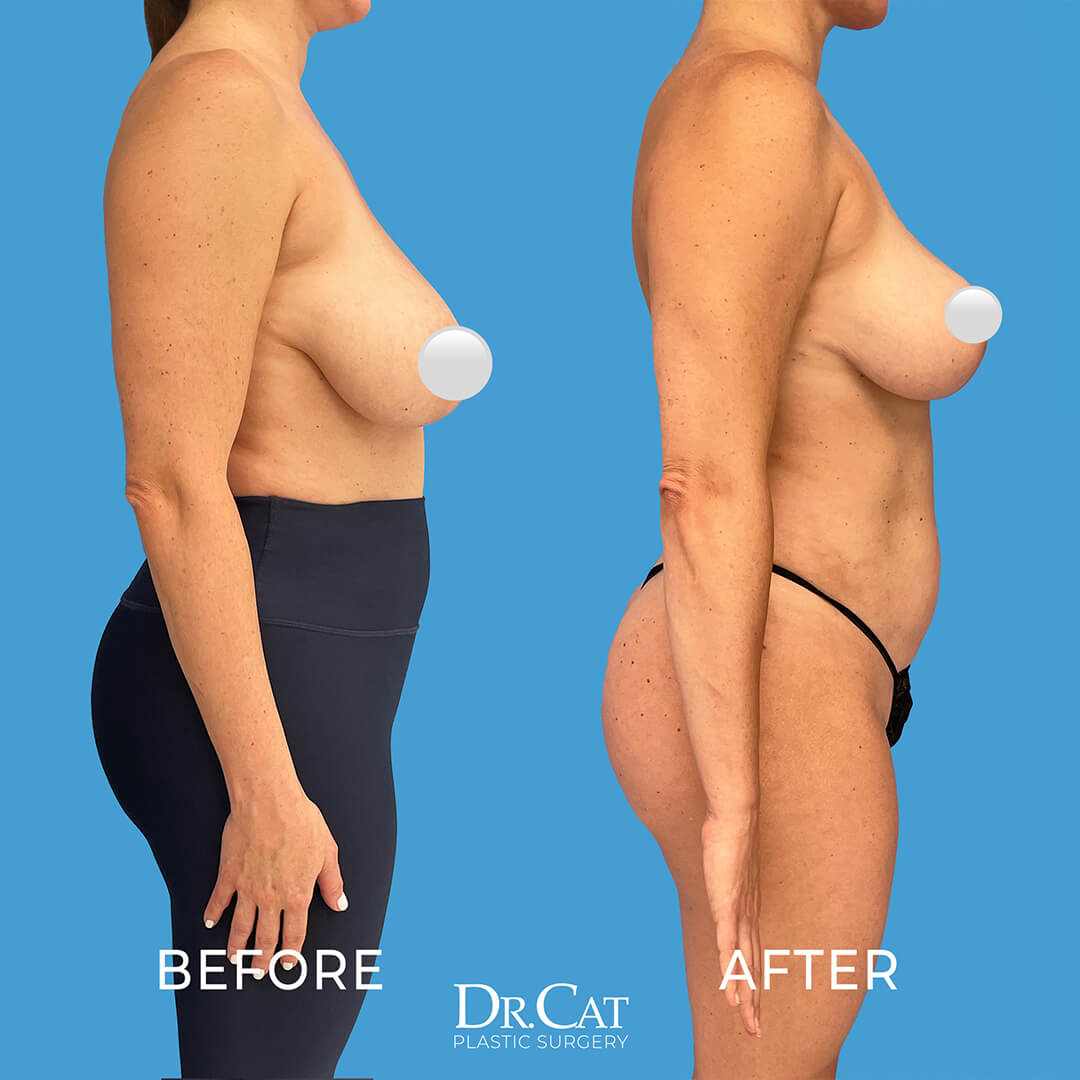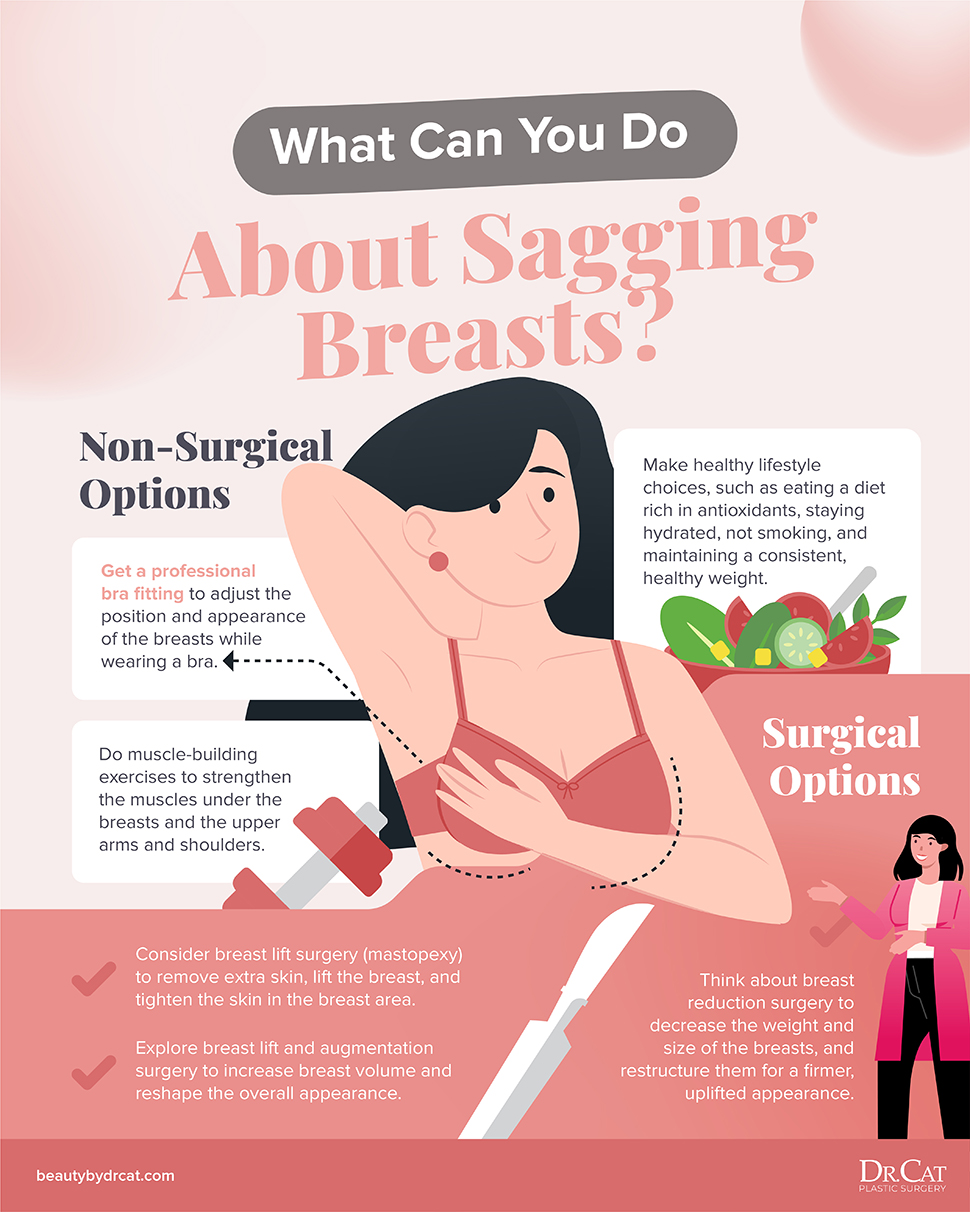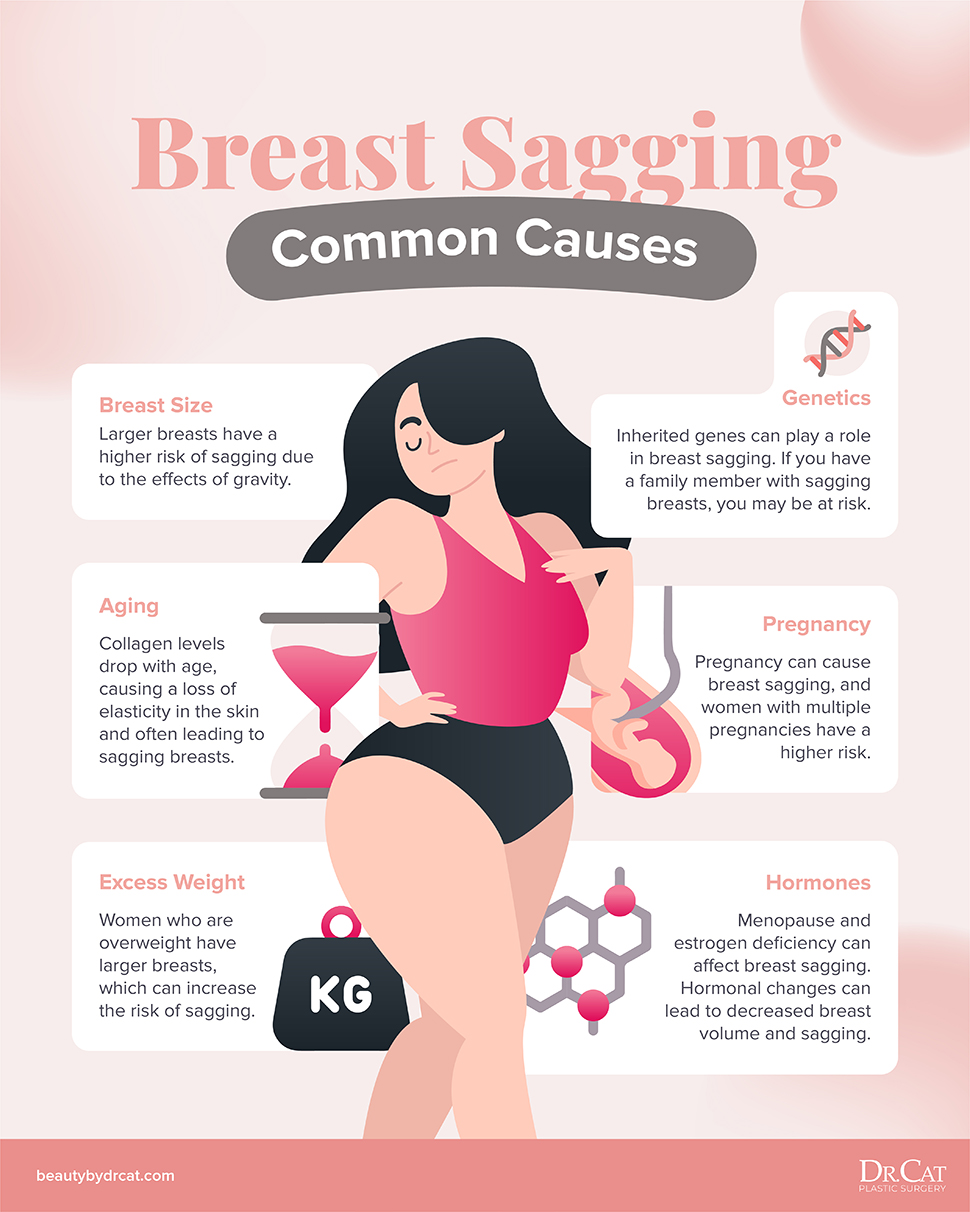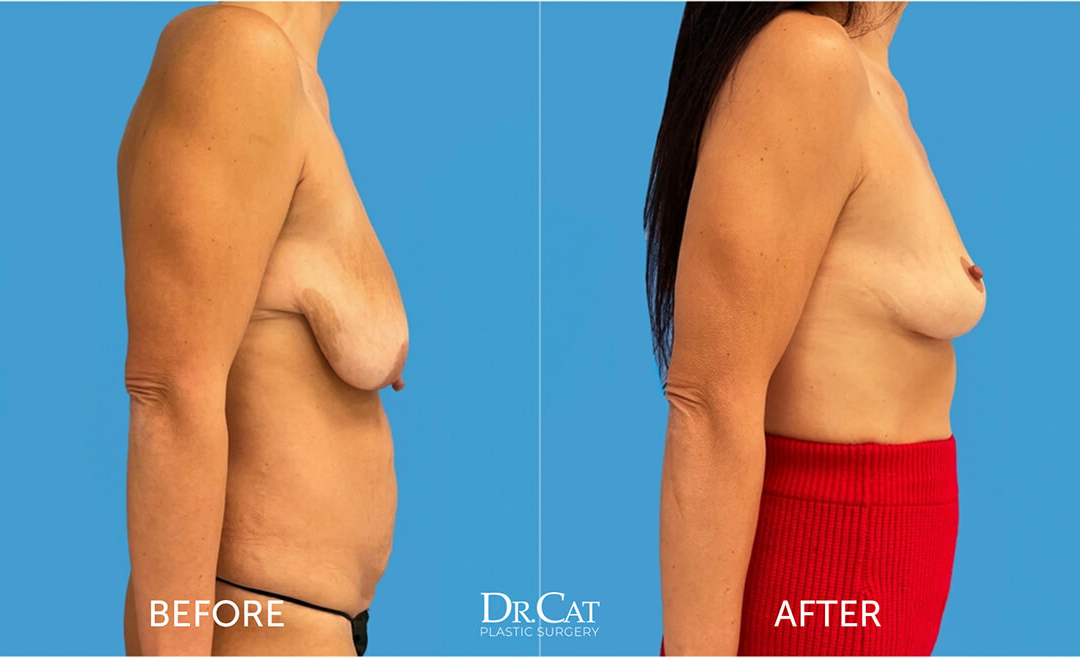Are you noticing that your breasts are starting to drop a little lower? There are different reasons why breasts sag, and many women feel self-conscious about these body changes. If you would like perky, youthful breasts but feel your breasts sit in a lower position and are deflated, you have various surgical options.
It’s important that you feel confident and happy about your overall appearance, including the shape and position of your breasts. If you notice changes and want to improve your breasts, it might be time to talk to a cosmetic surgeon about your options.
Breast Sagging: Common Causes
 Why is it common for women to experience sagging breasts? There are a variety of factors that can contribute to this condition:
Why is it common for women to experience sagging breasts? There are a variety of factors that can contribute to this condition:
- Breast Size: Women with larger breasts have a higher risk of sagging. When there is more breast mass, it’s expected that the effects of gravity can start to pull the breasts lower.
- Excess Weight: It’s normal for women to have extra fat in the breast area when they gain weight. Women who are overweight have larger breasts, which means their breasts might sag more compared to skinnier women.
- Aging: One of the most common causes is age. Collagen levels start to drop over the years, resulting in a loss of elasticity in the skin. Often, the breasts start to look wrinkled or saggy. This condition can also affect other areas of the body, not just the breasts.
- Genetics: Inherited genes play a significant role in many aspects of health and overall appearance. If you have a family member with sagging breasts, then it might mean that you are at risk as well.
- Hormones: Menopause and estrogen deficiency can affect breast sagging. As women age and their hormones shift, they often notice changes in breast position. For example, many women experience decreased breast volume as they go through menopause.
- Pregnancy: Going through pregnancy can cause breast sagging, and women with multiple pregnancies have a higher risk of sagging.
Breastfeeding as week as the changing weight and breast sizes during and after pregnancy can be substantial factors in breast position.
How the Breast Appearance Changes with Sagging
Not only are the breasts positioned lower when sagging occurs, but there are often other noticeable changes as well.
For example, you might see that the breasts are sitting lower on the chest, which changes the way the breast shape forms under your shirt. Many women have nipples that start to point downward. Or, the top of the breast might not have the same fullness as before.
Are My Breasts Sagging?
How do you tell if the breasts are sagging when you look in the mirror? Mild breast sagging isn’t as noticeable as moderate or severe sagging. So, you might not notice the changes in the early stages.
One at-home option to test your breast perkiness is the pencil test. Place a pencil so it sits flat against the wall, then position your breast over it. If the pencil falls, then it means that you have perky breasts. If the pencil stays in place because the tissue under the breast is holding the pencil, then it means that you are experiencing breast sagging. This “test” isn’t an official medical evaluation, but it can help you gain insight into the changes that might be occurring.
Also, you can tell that the overall appearance of the breasts starts to change. Look at the nipple position compared to the crease underneath the breast (the inframammary fold). If the nipple sits above this fold, you still have perky breasts. If the nipple is sitting below the fold, it means that sagging is starting to occur.
Different Grades of Sagging Breasts
Not all breast sagging is created equal. Doctors use a scale to determine how much sagging is occurring:
- Non-Sagging Breasts: The nipple is positioned above the inframammary fold.
- Grade 1: Mild sagging – the nipple is level with the inframammary fold.
- Grade 2: Moderate sagging – the nipple sits below the inframammary fold.
- Grade 3: Significant sagging – the nipple is positioned at the lowest point and turned downward.
- Pseudoptosis: Even though the nipple is level with the inframammary fold, there is still a sagging or downward pulling in the lower part of the breast.
What Can You Do About Sagging Breasts?
You can do different things at home to change how your breasts look. Rest assured, knowing that options are available, even without surgery.
- Professional Bra Fitting: The type of bra you wear won’t change your breasts. But you can adjust the position and appearance of the breasts while wearing the bra. A well-fitted bra positions the breasts so they look good under your clothing. It’s common to experience changes in bra size over time. So, find a clothing store that offers bra fitting to choose the ideal size for your breasts.
- Muscle Building Exercises: The breasts are made up mammary ducts and fat, which means that exercise won’t change the shape or tone of your breasts. But muscles located under the breasts can affect how the breasts are sitting on the chest. Work out these muscles, as well as the upper arms and shoulders, which can help the breasts sit a little higher on the chest wall.
Additionally, every woman should be proactive about preventing sagging breasts. Lifestyle habits play a significant role in how quickly the signs of aging show up. These lifestyle changes affect the entire body, helping to reduce the risk of sagging breasts, wrinkled skin, and more.
- Dietary Choices: No magic pill or ingredient will stop the aging process and counteract gravity. But if you are eating a diet loaded with antioxidants (including fruit and vegetables), then it has a positive impact on slowing down the aging process. Antioxidants counteract free radical activity, helping you maintain a more youthful appearance.
- Hydration: Make sure you are drinking plenty of water throughout the day. Also, avoid dehydrating drinks such as coffee and soda. When you are hydrated, it can help the skin look better.
- Don’t Smoke: Did you know that cigarette smoke causes a breakdown of collagen, which means that your skin can look less full? Be proactive about staying away from all types of tobacco. Not only can you slow the aging process, but avoiding tobacco is beneficial for improving overall health.
- Weight Management: When a person has fluctuating weight, the risk of sagging breasts goes up. Gaining weight increases the size of the breasts, then when you lose the weight, there is excess skin in that area. Sometimes the skin can’t snap back. Maintaining a consistent, healthy weight can reduce the risk of stretched skin around the breasts.
It’s normal and expected that changes would occur throughout your body with age. But you can slow down this process by making healthy lifestyle choices that support a youthful appearance and reduce the risk of sagging.
Breast Lift Surgery: Fast and Effective Solution
 The most effective fix for sagging breasts is through surgical intervention. Here are a few potential treatments that your surgeon might suggest, depending on your unique needs:
The most effective fix for sagging breasts is through surgical intervention. Here are a few potential treatments that your surgeon might suggest, depending on your unique needs:
Breast Lift Surgery
The medical term for breast lift surgery is mastopexy, an effective solution for creating a perky, youthful appearance. This treatment involves several steps to remove extra skin, lift the breast, and tighten the skin in the breast area. The surgeon is proactive about carefully positioning the breast in the ideal location.
When you are talking to the surgeon about your goals, it’s important to explain the position and shape that you desire. During the surgery, the doctor will reshape the breast so the nipple is lifted above the inframammary fold and leveled.
Breast Lift and Augmentation Surgery
The next option is a combination surgery that involves increasing the size of the breasts and lifting them at the same time. Since the loss of breast volume often contributes to the sagging breast tissue, it can cause the breasts to look deflated or turned down.
Augmenting the breasts with implants is an effective way to increase the volume again. Additionally, you can reshape and rejuvenate the overall appearance with a breast lift at the same time.
Breast Reduction
It might sound counter-intuitive, but reducing the size of the breasts can actually help to decrease sagging problems. Not only is the excess weight being removed to minimize the gravitational pull, but the breast can also be restructured during the surgery.
During a breast reduction procedure, excess skin and tissue are moved with the goal of making the breasts smaller. Additionally, this treatment helps to tighten the breasts and create a firmer, uplifted appearance without sagging.
How Long Do Results Last After Breast Surgery?
If you restore sagging breasts with an uplift and/or implant procedure, rest assured, knowing that the results will last for many years.
But it’s important to understand that the aging process always continues. So, the breasts can start sagging again after the surgery. Most people find that their breasts continue to look perky and beautiful for a long time, but eventually, they will start to fall again because of aging.
Recovery After Breast Surgery
 As with any type of surgery, you will need to plan time in your schedule for recovery. The body needs to heal from the incision and work that is done, so you won’t be able to return to your normal activities immediately. Be patient with yourself and plan plenty of time for recovery to ensure optimal results in the future.
As with any type of surgery, you will need to plan time in your schedule for recovery. The body needs to heal from the incision and work that is done, so you won’t be able to return to your normal activities immediately. Be patient with yourself and plan plenty of time for recovery to ensure optimal results in the future.
After surgery, you will feel weak and tired. During this time, you shouldn’t be doing any physical activities. Instead, stay in bed and watch a movie or read a book. Many people use pain medications for a week or two during recovery time.
Most patients find that they experience pain for 2 – 3 weeks after the surgery. It’s common to have a lot of bruising and swelling during the first few weeks as well. You might feel different sensations, such as stretching or pulling in the breast area.
You will need to plan for a follow-up surgery so the doctor can see how everything is healing. Often, some stitches need to be removed after 7 – 14 days.
It’s normal for the skin on the breasts to feel numb since the nerves were affected during the surgery. Typically, the sensations start to come back over time. Some women experience a permanent loss of feeling, mostly in the nipple area.
Tips to Support Your Recovery
Here are a few tips to keep in mind during your recovery:
- Rest: If you are tired, then take a nap. Give your body the rest that it needs to recover and heal.
- Lifting: Don’t lift anything that will make you strain during the first 6 weeks. For example, don’t pick up heavy grocery bags, backpacks, children, pets, and more.
- Sleep: Stay on your back while sleeping, with a pillow propped so your shoulders and head are raised. This position keeps the implants in place so they don’t shift or move while you are asleep.
- Timeline: Most people can return to their regular work or daily routine in 1 – 2 weeks.
- Diet: You can eat a regular diet during your recovery. Some people experience an upset stomach, and you can try adding bland foods to calm the stomach.
- Bowels: It’s common to have irregular bowels after any type of surgery. Make sure you are consuming plenty of fiber and use a mild laxative if needed.
Book a Consultation for Breast Surgery
Do you want to boost your confidence with breasts that feel like the ideal size and shape for your body? Then book a consultation with a local expert: Dr. Cat Begovic. Every patient is unique, which is why it can be helpful to talk to experienced surgeons about options and potential outcomes.
Not only does Dr. Cat offer breast surgery, but she can also help with many other cosmetic procedures, such as full mommy makeovers and minimally-invasive options such as ThermiSmooth.
You deserve to work with the best doctor in the industry. Call Dr. Cat because she is board-certified and has many years of experience with these surgical methods. Book a pre-consultation phone call with Dr. Cat’s office to start your surgical journey today!




